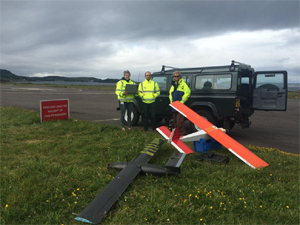



Date:31/03/16
 At first look, hydrogen fuel cells sound like an awesome force great power fixed-wing drones making long flights – they have any longer run times than batteries, and they radiate no emanations other than water vapor. Tragically, the hydrogen commonly must be put away in huge overwhelming pressurized tanks. A month ago, however, a Raptor E1 electric drone made an effective experimental run running on an exceptional new framework that is really lighter than the lithium-ion battery it supplanted.
At first look, hydrogen fuel cells sound like an awesome force great power fixed-wing drones making long flights – they have any longer run times than batteries, and they radiate no emanations other than water vapor. Tragically, the hydrogen commonly must be put away in huge overwhelming pressurized tanks. A month ago, however, a Raptor E1 electric drone made an effective experimental run running on an exceptional new framework that is really lighter than the lithium-ion battery it supplanted.
The flight was done on Jan. 19th at Scotland’s Oban Airport, by a group from the Scottish Association for Marine Science (SAMS). Despite the fact that the flight just kept going 10 minutes with the drone cruising at an elevation of 80 m (262 ft), the fuel cell allegedly had enough fuel to fly for two hours.
That fuel took the type of roughly 100 little strong pellets contained inside of an unpressurized cartridge. Made by Britain’s Cella Energy, those pellets are made out of an exclusive concoction compound, and they relentlessly deliver hydrogen gas when a little measure of warmth is connected. The Arcola Energy-fabricated fuel cell changes over that gas into power, which was utilized to control the drone’s engine.
As per Cella, the pellets (which measure 1 sq cm each) are steady amid unpleasant air travel, and at temperatures as warm as 50º C (122º F). Pressurized hydrogen, by complexity, must be put away at low temperatures.
First hydrogen cell powered drone takes-off
 At first look, hydrogen fuel cells sound like an awesome force great power fixed-wing drones making long flights – they have any longer run times than batteries, and they radiate no emanations other than water vapor. Tragically, the hydrogen commonly must be put away in huge overwhelming pressurized tanks. A month ago, however, a Raptor E1 electric drone made an effective experimental run running on an exceptional new framework that is really lighter than the lithium-ion battery it supplanted.
At first look, hydrogen fuel cells sound like an awesome force great power fixed-wing drones making long flights – they have any longer run times than batteries, and they radiate no emanations other than water vapor. Tragically, the hydrogen commonly must be put away in huge overwhelming pressurized tanks. A month ago, however, a Raptor E1 electric drone made an effective experimental run running on an exceptional new framework that is really lighter than the lithium-ion battery it supplanted.The flight was done on Jan. 19th at Scotland’s Oban Airport, by a group from the Scottish Association for Marine Science (SAMS). Despite the fact that the flight just kept going 10 minutes with the drone cruising at an elevation of 80 m (262 ft), the fuel cell allegedly had enough fuel to fly for two hours.
That fuel took the type of roughly 100 little strong pellets contained inside of an unpressurized cartridge. Made by Britain’s Cella Energy, those pellets are made out of an exclusive concoction compound, and they relentlessly deliver hydrogen gas when a little measure of warmth is connected. The Arcola Energy-fabricated fuel cell changes over that gas into power, which was utilized to control the drone’s engine.
As per Cella, the pellets (which measure 1 sq cm each) are steady amid unpleasant air travel, and at temperatures as warm as 50º C (122º F). Pressurized hydrogen, by complexity, must be put away at low temperatures.
Views: 611
©ictnews.az. All rights reserved.Similar news
- The mobile sector continues its lead
- Facebook counted 600 million active users
- Cell phone testing laboratory is planned to be built in Azerbaijan
- Tablets and riders outfitted quickly with 3G/4G modems
- The number of digital TV channels will double to 24 units
- Tax proposal in China gets massive online feedback
- Malaysia to implement biometric system at all entry points
- Korea to build Green Technology Centre
- Cisco Poised to Help China Keep an Eye on Its Citizens
- 3G speed in Azerbaijan is higher than in UK
- Government of Canada Announces Investment in Green Innovation for Canada
- Electric cars in Azerbaijan
- Dominican Republic Govt Issues Cashless Benefits
- Spain raises €1.65bn from spectrum auction
- Camden Council boosts mobile security





















